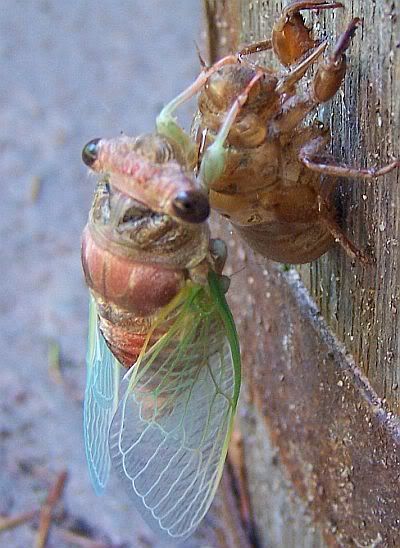
Things are changing around the riverrim. The noise makers of August are filling the air with songs.
By day, the cicadas drone by means of a vibrating membrane (located in the abdomen) called timbals. At night, the katydids take their turn. They sing songs by way of stridulation, they have special organs at the bottom of their wings which they rub together. Grasshoppers rub their hind legs together to stridulate. Crickets are also stridulators (wait, I don't think that is actually a word--but you know what I mean).
At any rate, living in the woods in August leads to a non stop cacophony- that varies slightly with the temperature. Some would say they enjoy the songs, others complain about the monotonous noise. What are they all singing about? If you believe the old folk tales, they are warning that there are only 6 weeks left until the first frost. Six weeks to get it all done. Six weeks ...humm...maybe they know the ground hog.
They could be singing about weaving. Really. I read about it on the Internet. A study of the diverse field of ancient Chinese literature reveals a great number of farmer's proverbs or popular songs relating to insects. A clear example of people listening to singing insects is found in ancient literature. When the cricket, "Cu Zhi" (meaning encourage weaving) is found singing indoors it is October and the ladies expedite their weaving efforts to ensure sufficient cloth for the coming Winter.
Btw, the cicada shown in the photograph has just emerged from approximately 8 feet under...where it has spent about 2-5 years in its nymph like state. It is not the Magicicada. They emerge every 13-17 years. You can tell them by their red eyes. They will come out in my neck of the woods again in 2013, and are identified as Brood #II.



11 comments:
For the last few days, I've heard the cicadas in my neighborhood. My son and I were just remarking how wonderful it is to hear them. He said he can't understand how people find the sound annoying. We both agreed that it's very reassuring to hear them again. We live in Manhattan, so it's very special to us to feel such a connection to the natural rhythm of things. :)
GREAT title, Cyndy! :D
Our bugs come out in early July when the humidity kicks up a notch. I've always called them cicadas, but I'm not sure what they are or what brood they're from. I don't even notice the sound much anymore, but my SIL came for a visit and said several times, What IS that awful noise?
I love hearing the sound. We used to also call it the heat bug song.
I also love finding the cast offs, great shot.
Amazing photo! You should enter it in the state fair or something.
I love laying in bed at night and listen to the crickets and frogs. It's a reassuring sound that all is right in this little space.
One time we got a katydid in our house and boy was it loud! That has led me to believe there are really only a half dozen of them out there making all that racket! Ha Ha Ha! Can you imagine me wondering around in the night trying to count katydids? I'd try to sneak up on them so they didn't stop making noise!
WoW another amazing photo. Alas no cicadas here in Wales but grasshoppers we do have on sunny days and I love to listen to them; makes me feel sort of lazy and relaxed
I love to hear them talk but I don't like what they are saying! There is only 35 days until autumn...not enough time.
Oh, you have some of those 17 year cicadas! My dad was telling me about these. I appreciate your comment about spinning alpaca! I was thinking I just got an exceptionally dirty fleece, but apparently not. It was fun to see how nicely the yarn washed up.
Great photos as always. My little girl is facinated as usual of your nature photos even if she's too young to understand the details!
awesome. I've never seen one actually coming out of its shell. Very cool that you were able to capture new body and old body together.
Post a Comment